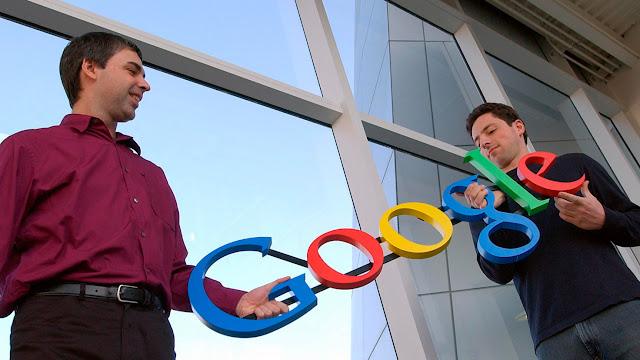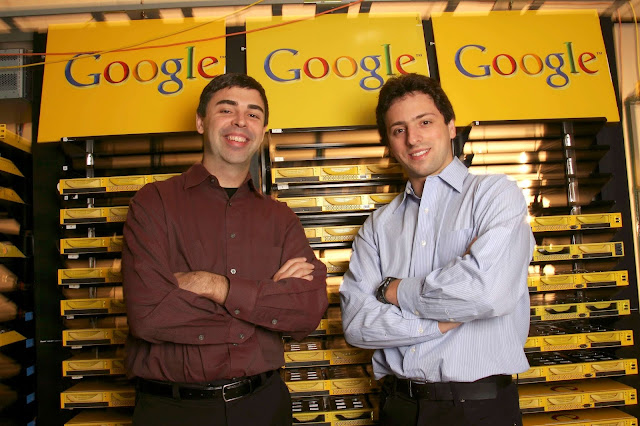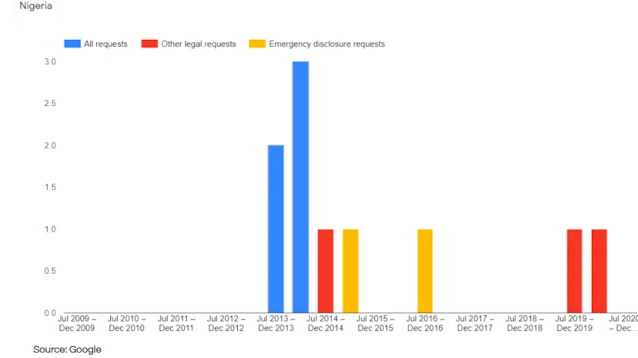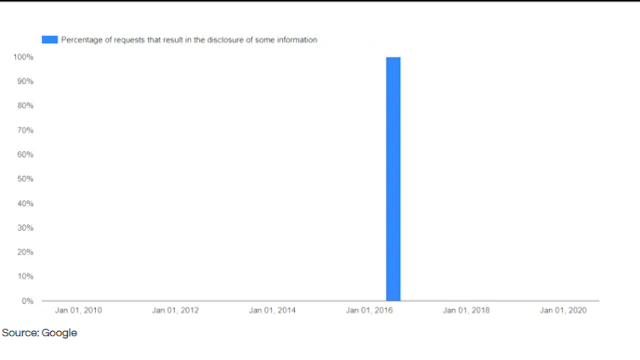The first rain of checks dropped on Google in August 1998. A Silicon Valley angel investor, Andy Bechtolsheim, invested $100,000, despite no plan by the founders to make money off the search engine.
The start
1. Google was created by two Computer Science PhD students of Stanford University. Their names are: Sergey Brin (Born: August 13, 1973) and Larry Page (Born: December 12, 1972). According to Page, “we didn’t know exactly what we wanted to do” at the time they started the company. Google is headquartered in Mountain View, California but started its journey at the Stanford University campus.
2. The original name of Google is a mathematical term and it is spelt g-o-o-g-o-l. It is equivalent to ten raised to the power of a hundred 10100. Sean Anderson, an associate of Page while trying to register the name googol misspelt it and typed google. Recalling the moment, Anderson said; “…I came in the next morning and Tamara had written a note saying, ‘You mispelled it. It is supposed to be G-o-o-g-o-l”. The domain with the correct spelling had however been taken. By the way, Tamara Munzner is one of Larry Page’s office mates at Gate 360. Bill Gate donated $6 million towards the construction of the office building known as William Gates Computer Science.
3. According to The Google Story, a book that chronicled the duo’s journey, Page summarised a contributing factor to their success, thus; “We worked through holidays, and worked many, many hours a day. It ended up working out, but it is hard because it takes a lot of effort”. Brin however disclosed; “growing up, I didn’t have the internet, or not in its current form, the World Wide Web”.
4. The culture at Standford University encouraged the founding of Google. At the time, unlike other institutions like the Massachusetts Institute of Technology (MIT), Stanford allows its PhD students to work on commercial products using the university’s resources. However, other institutions in the country have embraced this culture. Dropbox for instance was born in MIT.
Google’s competitive edge
5. Google’s search competitive edge is its PageRank consisting of 500 million variables and two billion terms. The technology unlike anything other search technology at the time returns the most relevant Web site to their search query. In simple terms, Google technology ranks websites based on their online reputation. This implies a site quoted by many other sites for its good content related to a keyword is more likely to rank best.
Prudency and search for funds
5. To keep up with the constant need to increase computers for their database, Google founders saved money by buying parts and building their own machines. They also borrowed unclaimed computers anywhere they could lay their hands on them. Their advisors also funded them with $10,000 courtesy the Stanford Digital Libraries Project.
Turned down by search giants
6. Prior to the emergence of Google, AltaVista and Excite were two dominating search engines in the world of the internet. These two (AltaVista and Excite) are erstwhile. Yahoo was and still is much of a directory. However, Google now has many more to compete with. DuckDuckGo, Ask.com, Bing, etc.
7. In March 1998, Google founders approached AltaVista to purchase their technology for $1 million with a guarantee that the technology will increase AltaVista’s share of the search market by 54 per cent. The company turned them down. Likewise, Excite, Yahoo and other search engines at the time turned down the offer to purchase the PageRank system. Yahoo co-founder, David Filo, however, advised them to take a leave of absence from their PhD programmes and focus on Google.
Investment without business plan
8. The first rain of checks dropped on Google in August 1998. A Silicon Valley angel investor, Andy Bechtolsheim, invested $100,000, despite no plan by the founders to make money off the search engine. Google had no business plan at this stage! The check was kept away for two weeks by the founders until the company was incorporated and the money was deposited.
9. Google founders went ahead, heads up with confidence bolstered by the $100,000 investment to seek funding from family and friends. They were able to raise $1million in total. They also took a leave of absence in the fall of 1998 and moved their office to Menlo Park on September 4, 1998, where they paid $1,700 a month for a property that is rented for $1,500. At this time, they also hired a fellow PhD student Craig Silverstein as their first employee.
10. Despite being in its beta stage (test form), Google was ranked in the Top 100 Web Sites and Search Engines by PC Magazine in 1998.
11. Still without a business plan (to make money), Google in 1999 running low on cash decided to raise additional money. They were however able to raise $25,000 from two egomaniac investment companies. Google however resorted to license its PageRank technology to generate income.
12. To get into the advertising market without displaying annoying ads, the Google team found an answer in a company that serves its ads next to search result on Yahoo. Google however did not hire the company, Overture Inc. They instead went ahead to write their own software so they can have all control over displayed Ads on Google and also keep all the earnings to themselves. Google is now worth over $1.5 trillion.Google generated $183 billion in revenue in 2020. According to the company’s report, $147 billion — over 80% — came from Google’s ads.
Many products of Google
13. Today, Google has numerous products aside from its Search engine. Some of them include:
| Subsidiary | Business | Executive Leader |
| Calico | Human health (by overcoming aging) | Arthur D. Levinson |
| CapitalG | Private equity for growth stage technology companies | David Lawee |
| DeepMind | Artificial intelligence | Demis Hassabis |
| Fitbit | Fitness wearables | James Park |
| Internet services | Sundar Pichai | |
| Google Fiber | Internet access: via fibre | Dinesh Jain |
| GV | Venture capital for technology companies | David Krane |
| Intrinsic | Robotics software | Wendy Tan White |
| Sidewalk Labs | Urban innovation: infrastructure through technological solutions | Dan Doctoroff |
| Verily | Human health | Andrew Conrad |
| X | Research and development for “moonshot” technologies | Astro Teller |
| Waymo | Autonomous driving | John Krafcik |
| Wing | Drone-based delivery of freight | James Ryan Burges |
Source: Wikipedia. Note, details might have changed since the date the table was retrieved.
Change of name
14. Larry Page being the then-CEO announced on August 10, 2015, its plan to create a new public holding company to house all of its subsidiaries including Google. Today, the company is now known as Alphabet Inc. Page and Brin announced in 2019 they would be stepping down from their role as CEO and President respectively; but remain on Alphabet Inc.’s board.
15. The name Alphabet was rumoured to have been inspired by the location of the then Google Hamburg office’s street address: ABC-Straße. This was confirmed in a 2018 talk by Eric Emerson Schmidt (born April 27, 1955). He was the CEO of Google from 2001 to 2011. He also served as the executive chairman of Google from 2011 to 2015. He became the executive chairman of Alphabet Inc. in 2015 and served till 2017 when he was named Technical Advisor at Alphabet from 2017 to 2020.
Data privacy
16. Google has come under heavy criticism for heavily violating users data privacy. The company is suspected of collecting and aggregating data about Internet users through the various tools it provides to developers, such as Google Analytics, Google Play Services, reCAPTCHA, Google Fonts, and Google APIs. Most of these data were collected by Google to effectively target users with related Ads.
17. In 2008, Consumer Watchdog produced a video showing how Google Chrome records what a user types into the web address field and sends that information to Google servers to populate search suggestions.
18. Google Chrome includes a private browsing feature called “incognito browsing mode” that prevents the browser from permanently storing any browsing or download history information or cookies. Using incognito mode prevents tracking by the browser. However, the individual websites visited can still track and store information about visits. In particular, any searches performed while signed into a Google account will be saved as part of the account’s web history. In addition, other programs such as those used to stream media files, which are invoked from within Chrome, may still record history information, even when incognito mode is being used.
19. Google’s online map service, “Street View”, has been accused of taking pictures and viewing too far into people’s private homes and/or too close to people on the street when they do not know they are being photographed.
20. From 2006 to 2010, Google Streetview camera cars collected about 600 gigabytes of data from users of unencrypted public and private Wi-Fi networks in more than 30 countries. No disclosures nor privacy policy was given to those affected, nor to the owners of the Wi-Fi stations.
21. In 2019, a Chicago court was sued for selling patient data to Alphabet Inc.’s Google to develop artificial intelligence products. A similar case was reported in a suit against Alphabet and Accenture. Google was granted access to the health records of millions of Americans through a partnership. Ascension is one of the largest private healthcare systems in the United States, ranking second in the United States by the number of hospitals as of 2019.
22. To improve transparency on users’ data requests by individuals and government, the search giant in 2010 launched an online tool breaking down the figures which it hopes will be “just the first step toward increased transparency”.
23. Google today September 27, 2021, celebrates its 23rd birthday with a Google Doodle. The doodle was first experimented with in 1999 when the Google team planned to attend the Burning Man event. They replaced the second “o” of Google with the image of a Man.
Culled: Vanguard Newspaper






























![The Statesman’s Return — OGD in the Senate and the Rebirth of Strategic National Leadership [Part 5]](https://newsheadline247.com/wp-content/uploads/2024/07/Gbenga-Daniel-newsheadline247_1-324x160.jpeg)